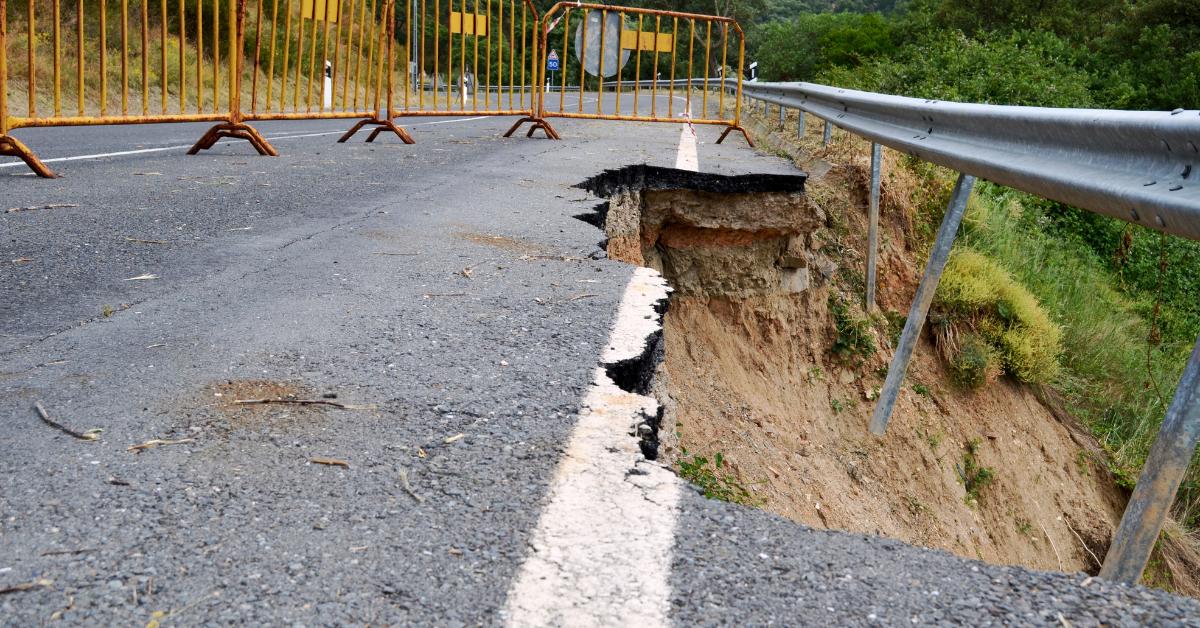When road banks are eroded by nearby rivers, floods, or construction, it can cause significant damage that is both costly and dangerous. Creating a strategy for how to mitigate road erosion can give you peace of mind and prevent a lot of problems from happening when your roadways experience flooding.
What Causes Road Erosion?
There are two ways that roads can be eroded, from above and from below. Both can be dangerous and costly, and both have their own warning signs to watch out for.
Traffic
One of the biggest factors in road erosion is heavy traffic combined with a lack of proper maintenance. Dirt roads are especially vulnerable to erosion, but asphalt roads that experience traffic from heavy trucks, tractors, or equipment can also be an issue. Salt used to melt ice and snow in the winter can also eat away at the asphalt and lead to soil erosion.
Flooding
Heavy flooding can wash away whole sections of roadway, especially if there are already existing structural weaknesses in and under the asphalt. If you see areas along the roadway where water is pooling, those are likely to be problem areas if you experience a major flood.
Flooding can also be a major issue below the road. If the road is near a river, creek, or other body of water, a flood can break away at the road bank and undermine the roadway. This can be especially dangerous because a driver may not be able to see the damage from their vehicle.
Road Erosion Prevention Methods
There are a number of ways to prevent your road from eroding. In order for them to be effective, you must first diagnose the erosion issue and come up with the best solution to match it.
Culverts and Drainage
One of the best ways to prevent road erosion is through a proper drainage system. Installing culverts to deal with stormwater runoff will help prevent water from pooling and running in areas where it can break away dirt and asphalt.
A sloped road can also help prevent pooling and quickly drain the water away from the roadway. Whenever you are installing drainage systems, it’s important to make sure that the water will drain to an area that can handle it without causing further erosion or damage.
Constructed Wetlands
This can be a large and expensive proposition, and it will depend on your location, but it can be a good way to mitigate erosion while promoting natural wildlife. A constructed wetland can provide a barrier that will absorb water and prevent flooding around your roads.
Bank Stabilization and Flood Retaining Walls
One of the most effective (and cost-effective) methods for preventing flooding from causing road bank erosion is stabilization. This can come in a number of methods that are both permanent and temporary.
Some options for road bank stabilization include ripraps, geogrids, and planting vegetation. Each option has both its advantages and disadvantages. Rip raps are a strong barrier against erosion, but they are expensive and time-consuming to deploy. They aren’t the most aesthetically pleasing option either. Vegetation can provide a habitat for local wildlife, but it can’t be deployed in an emergency, and it may not stand up to some of the strongest water currents.
TrapBags have been used to stabilize riverbanks that would otherwise have been washed away. They can be filled with concrete, washed gravel, and other materials in order to provide a solid wall against erosion.
How to Build a Retaining Wall with TrapBag
A TrapBag water retaining wall can be ordered in sections and constructed by a small crew of people using heavy equipment within just a few hours. They need 40% less fill material than sandbags and can be deployed much more efficiently.
TrapBags have been used to form seawalls in the wake of hurricanes and protect key infrastructure from flooding. Their flexibility allows them to be used for a wide range of flood protection uses, including dams and levees. They have also been used by mining, construction, and industrial companies to protect their operations from flooding and protect the surrounding area from chemical spills.
If a roadway has been damaged by erosion and flooding, a TrapBag flood barrier can buy your team the time and space they need to repair or replace the road.
Why Choose TrapBag?
Unlike sandbags, TrapBags have been engineered in a pentagon-like shape to ensure structural integrity and strength. They can be used to protect against hurricanes, mudslides, and stormwater overflows.
Bank Erosion Protection Projects
TrapBags were used to stabilize the banks of a river that was beginning to erode in Carson City, Nevada in 2021. Around 2,000 feet of TrapBags were installed to protect a mobile home park in the area.
They were also deployed to protect a cottage on Lake Michigan from falling victim to erosion in 2020. When the family saw their vacation cottage’s deck fall into the lake after being hit by major waves, they called TrapBag to quickly set up a barrier to keep the entire building from collapsing. Contractors said the cottage would have been destroyed within a matter of weeks if TrapBag wasn’t deployed.
The Iowa Department of Transportation deployed TrapBags to prevent flooding on Interstate 29. The water barrier prevented flooding from the Missouri River from reaching the road and shutting down traffic.
Order TrapBag Today
Ready to protect your roads from erosion and flooding? Order TrapBag today to be prepared when severe rainfall comes to your area.


